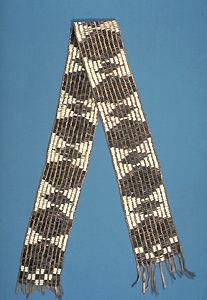Indigenous treaties in Canada are agreements made between the Crown and Indigenous peoples. These agreements typically concern land. Indigenous peoples agreed to share their land in exchange for payments and promises. Before Confederation, Britain controlled the treaty making process. After Confederation, the federal government took control of the treating making process.
This article is a plain-language summary of Treaties with Indigenous Peoples in Canada. If you are interested in reading about this topic more in depth, please see our full-length entry, Treaties with Indigenous Peoples in Canada.
The Royal Proclamation of 1763 created the land treaty system that followed it. It stated that only the Crown could negotiate treaties with Indigenous peoples. Before Confederation, the British made many treaties with Indigenous peoples. As a result, the Crown claimed possession of much Indigenous land (see also Indigenous Territory). Many of these early treaties, including the Peace and Friendship Treaties, did not include surrendering land. Indigenous peoples often did not understand the written terms of treaties. In many instances, they trusted the word of translators and the oral promises of treaty commissioners. By the 1830s, most of the farmland in Upper Canada (Ontario) had been taken over by the Crown.

After 1867, the federal government controlled the treaty making process. Some of the most important treaties they made are called the Numbered Treaties. There are 11 Numbered Treaties. They were made between 1871 and 1921. As a result of the treaties, the federal government claimed control of vast amounts of land in western and northern Canada. The federal government wanted this land for settlers. However, many Indigenous peoples did not believe they were giving up their land. Some Indigenous peoples understood treaties to be about sharing the land.
The federal government promised that it would help Indigenous peoples in return for the land. The government promised it would provide Indigenous peoples with education, money and materials. However, the government broke many of these promises. It also made Indigenous peoples live on reserves. They did not have freedom of movement. Indigenous peoples suffered a lot because of government views of these treaties.
Elsewhere in Canada, settlers simply moved onto Indigenous land without permission. Soon after, Indigenous peoples were forced to live on reserves.
Indigenous peoples have often challenged government views of treaties. For example, the Nisga’a people in British Columbia have argued that they never gave up rights to their land. They later signed a treaty with the federal government. They gained control of 2,000 km2 of land. In 2000, they achieved self-government (see Indigenous Self-Government in Canada). In the 1970s, the Cree and Inuit protested Hydro-Québec’s James Bay Project. Hydro-Québec did not consult them about using their land. In 1975, the governments signed the James Bay and Northern Quebec Agreement (JBNQA). This is seen as the first “modern treaty.” The Cree and Inuit gained self-government.
The federal government and Indigenous peoples have signed many treaties since the JBNQA. In 1993, the federal government and the Inuit signed the Nunavut Land Claims Agreement. This eventually led to the creation of Nunavut in 1999. In the future, there will certainly be more treaties.

 Share on Facebook
Share on Facebook Share on X
Share on X Share by Email
Share by Email Share on Google Classroom
Share on Google Classroom












